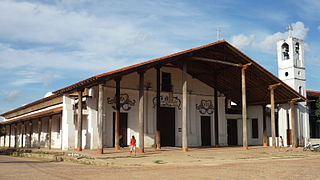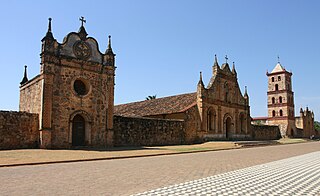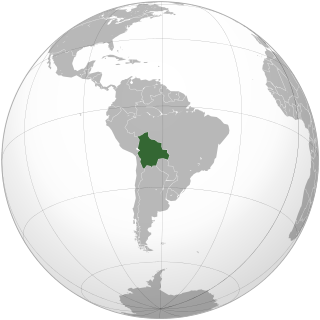
Pando is a department in Northern Bolivia, with an area of 63,827 square kilometres (24,644 sq mi), in the Amazon Rainforest, adjoining the border with Brazil and Perú. Pando has a population of 154,355. Its capital is the city of Cobija.

Trinidad, officially La Santísima Trinidad, is a city in Bolivia, capital of the department of Beni. The population is 130,000. While historically a peripheral city in Bolivia, Trinidad is today an important center for the Bolivian Bovine industry and has enjoyed a modest economic boom in recent years and enjoys an HDI index of above 0.700.
The Confederation of Indigenous Peoples of Bolivia is a national representative organization of the Bolivian indigenous movement. It was founded in October 1982 in Santa Cruz de la Sierra as the Confederation of Indigenous Peoples of the Bolivian East, with the participation of representatives of four indigenous peoples of the Bolivian East: Guarani-Izoceños, Chiquitanos, Ayoreos and Guarayos.
Chiquitano is an indigenous language isolate spoken in the central region of Santa Cruz Department of eastern Bolivia and the state of Mato Grosso in Brazil.

San Ignacio de Velasco, is the capital of the José Miguel de Velasco Province and the San Ignacio de Velasco Municipality in the Santa Cruz Department of Bolivia.
Reyesano, or Chirigua (Chiriba), is a nearly extinct Tacanan language that was spoken by only a few speakers, including children, in 1961 in Bolivia. It is spoken by the Maropa people who number 4,505 in 2012.

The Media Luna or Media Luna Ampliada refers to a group of four departments – Santa Cruz, Beni, Pando, and Tarija – in Bolivia which are home to a greater proportion of opponents to the national government led by Evo Morales and the Movement for Socialism (MAS) than the rest of the country. Pando has seen increasing support for MAS since 2009, while Tarija was initially supportive but has opposed MAS in every election after 2014. In contrast to the predominantly Indigenous Andean populations of the Andean region such as La Paz and Cochabamba, the departments in the Media Luna are majority mestizo, as well as being made up of the remaining 26 groups of lowland indigenes with white minorities, specifically in Santa Cruz de la Sierra.
Loreto is a smalI municipality in the Beni Department in northern Bolivia, capital of the Marbán Province and Loreto Municipality. In 2001, Loreto had a population of 843.

San Ignacio de Moxos is a town in the Beni Department of northern Bolivia.

Concepción is a town in the lowlands of eastern Bolivia. It is known as part of the Jesuit Missions of Chiquitos, declared in 1990 a World Heritage Site, as a former Jesuit Reduction.

San Rafael de Velasco or San Rafael is the seat of the San Rafael Municipality in the José Miguel de Velasco Province, Santa Cruz Department, Bolivia. It is part of the Jesuit Missions of Chiquitos. In 1990 it was declared a World Heritage Site.

San José de Chiquitos, or simply San José, is the capital of Chiquitos Province in the Santa Cruz Department, Bolivia. It is known as part of the Jesuit Missions of the Chiquitos, which is declared in 1990 a World Heritage Site, as a former Jesuit Reduction.

San Javier is the seat of San Javier Municipality in Ñuflo de Chávez Province, Santa Cruz Department, Bolivia. The mission of San Javier is known as part of the Jesuit Missions of the Chiquitos, declared in 1990 a World Heritage Site, as a former Jesuit Reduction.

San Miguel de Velasco or simply San Miguel is a town in the Santa Cruz Department, Bolivia. It is the capital of San Miguel Municipality, the second municipal section of José Miguel de Velasco Province. It is known as part of the Jesuit Missions of the Chiquitos, which was declared a World Heritage Site in 1990, as a former Jesuit Reduction. The wood and adobe church has an elaborate interior.

Santa Ana de Velasco is a small town in the Santa Cruz Department, Bolivia.
San Javier (Beni) is a small town in Bolivia.

Bolivian Spanish is the variety of Spanish spoken by the majority of the population in Bolivia, either as a mother tongue or as a second language. Within the Spanish of Bolivia there are different regional varieties. In the border areas, Bolivia shares dialectal features with the neighboring countries.

Santiago de Chiquitos is a small town in Roboré Municipality in Chiquitos Province, Santa Cruz Department, Bolivia. The mission of Santiago de Chiquitos is one of the Jesuit Missions of the Chiquitos.
San Juan de Taperas is a village in San José de Chiquitos Municipality in Chiquitos Province, Santa Cruz Department, Bolivia. The ruins of the mission of San Juan Bautista, one of the Jesuit Missions of the Chiquitos, lie near the village. Since only the ruins of a stone tower survive near the present village of San Juan de Taperas, San Juan Bautista is not one of the six Jesuit Missions of Chiquitos recognized as UNESCO World Heritage Sites.
Santo Corazón is a village in San Matías Municipality in Ángel Sandoval Province, Santa Cruz Department, eastern Bolivia. The mission of Santo Corazón is one of the Jesuit Missions of the Chiquitos.












